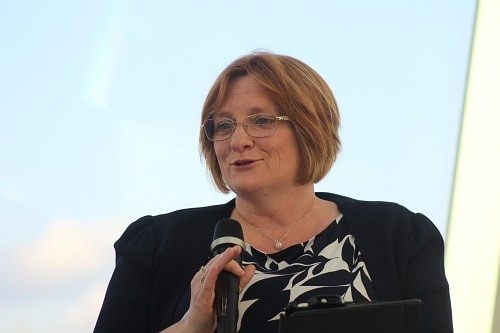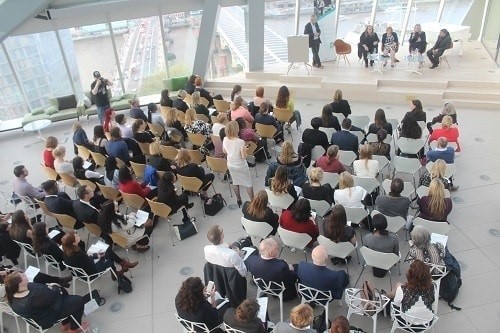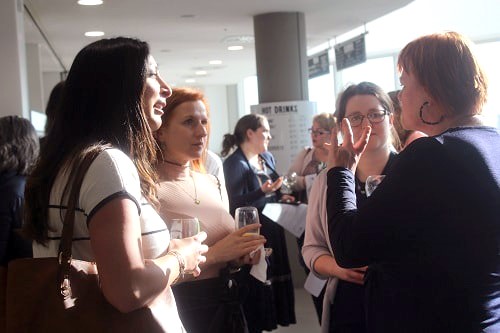Almost half (47 per cent) of workers in the UK are female, so why are there comparatively few women working in health and safety? Belinda Liversedge attended Women in Health and Safety’s first panel event to find out.
Features
Where is SHE?
Health and safety is a vast discipline covering so many industries and workplaces, something that should make it open to many different minds, skills, interests and people regardless of their gender.
But while many women have gone on to enjoy careers in health and safety, it is still the case that men far outnumber them. IOSH’s membership is 19.7 per cent female and research by the TUC in 2011 found that women constitute 27 per cent of trade union health and safety representatives sitting on health and safety committees at workplaces. It’s also plain to see: at a recent awards ceremony for health and safety, one Twitter post asked, ‘Where are all the women’?
Events like the gender pay gap reporting requirements recently published have prompted companies around the country to look at issues such as bias and stereotyping that may be perpetuating gender imbalance within their workforces. Keen to investigate the issues in health and safety and to find out why it is that women are under-represented, particularly in leadership roles, we headed down to Breaking down Barriers, a panel hosted by Women in Health and Safety, a network of people who support gender equality in their profession, and spoke to industry professionals to find out.
Lynn Way, vice president of National Access and Scaffolding Confederation, is the second most senior person in her organisation, with over 20 years’ experience in scaffolding.
Yet, she still finds her authority questioned because of her gender, she told the audience at the event on 2 May. She recalled how, as she was conducting a safety audit, a worker stared at her, walked off, then came back and told her she couldn’t do her job: “You’re a woman, women can’t handle men.” Her experience is symptomatic of lingering sexist attitudes in male-dominated workplaces like construction.
 Lynn Way, vice president of National Access and Scaffolding Confederation spoke at Women in Health and Safety’s event in London
Lynn Way, vice president of National Access and Scaffolding Confederation spoke at Women in Health and Safety’s event in London
A July 2017 survey by the Royal Institution of Chartered Surveyors (RICS) found that nearly one third of women in construction said a fear of sexism held them back from pursuing senior roles. It was also backed by a January 2017 survey by Hays Recruitment that found 73 per cent of female engineers have experienced sexual discrimination, harassment or victimisation at work.
“These attitudes [that women aren’t good enough] have to go,” said Lynn. Holly Price, director of training at Keltbray Group, agreed: “We’re dealing with legacy issues. I don’t believe it’s the people in the workplace today who have created them, but I do think it is the responsibility of us in the workplace today to fix these for future generations.”
 An audience heard from four leaders flying the flag for equal opportunities in health and safety at the event
An audience heard from four leaders flying the flag for equal opportunities in health and safety at the event
Closing the gap
More positively, when it comes to attracting more female talent into health and safety, is how some good work is being done by trailblazing companies to modernise the selection process and advertising of jobs.
Mark Lomas, head of equality, diversity and inclusion at High Speed 2, talked about how they do not use CVs and instead have started using ‘blind auditioning’, involving an anonymous technical assessment at the first stage. Female applicant success rates have jumped from 17 per cent in shortlisting to over 50 per cent. “I’m not a believer that women need more development programmes or more training in more assertiveness or confidence. I believe the selection and evaluation process is fundamentally flawed and that is the biggest barrier [for women] right now,” he said.
Jacqueline O’Donovan, MD of O’Donovan Waste Disposal, had heard of a project at the Department of Transport to encourage women to apply for roles through thoughtful advertising. For example, adverts for site work also state whether there are changing and shower facilities for women. “Those items should be engrained in the job spec or advert, which aren’t at the moment,” she emphasised.
On the other hand, others said that there was too much of a tokenistic approach to advertising. “In our sector there’s a fine line between having women’s faces everywhere, promoting the ‘I’ve got women in our company’, which we’re seeing way too much of currently, instead of encouraging women in general into an industry. They are two different aspects,” said Lynn.
The face of health and safety
Then there is the perennial issue of health and safety’s image problem. Many people we spoke to for this article said the face of health and safety is still very much white, middle aged and male. “I think there is a huge stereotype image – and it is not necessarily just affecting females. I think the image of an older grey haired male safety practitioner does put people off – and is still prevalent,” said Tim Briggs, course director for safety, health and environmental courses at Leeds Beckett University.
Nicole Vasquez, director at Worthwhile Training, a health and safety training and consultancy company, said she even avoids telling people she works in health and safety because “there’s an image of what that portrays”. That image is “not attracting women into the industry”: “I think people think it’s very technical whereas to me health and safety is much more about people. I think if we could somehow get that message out there then it wouldn’t be just attractive to men.”
 HR, health and safety professionals and engineers on High Speed 2 networked at the event
HR, health and safety professionals and engineers on High Speed 2 networked at the event
However, health and safety’s image shows some signs of softening, with clients on the look out for a broader skill set and adverts reflecting their choices. Shirley Parsons, who has worked in recruitment for over 40 years, said clients are asking for well-rounded professionals through adverts which are ‘much less policeman style, they are more about influencing, leadership skills and communication.’ “There’s more emphasis on softer skills now,” she said.
Founder of recruitment firm Irwin & Colton, James Irwin, said that this in turn could help attract more women. “I think clients across all industries are calling out for people who can engage with businesses, who can communicate ideas and show empathy and these are skills that traditionally women are much stronger at than men – particularly in big construction companies, these skills are essential. It could be that increasing speed of females in these roles is really going to drive the health and safety profession forward.”
The next major change is that young people are choosing health and safety as a career more and more, rather than falling into it as a second choice. Health and safety, in the context of pressures like mortgages and university fees, has become a stable and attractive career for young millennials, said Tim Briggs.
“It is not just confined to female students [but young people] realise that they will get a reasonably well paid job, which will help them pay off any student debts. [They also see] that if you want a role where you can help protect people and make a positive contribution to society, health and safety is one of those unsung careers where you can get immense job satisfaction.” Although boys still outnumber girls at undergraduate level, it is starting to even out at postgraduate where the ratio is 60/40.
Femininity – a weakness in the boardroom?
The gender pay gap reports have indicated many issues, including imbalances in pay, opportunity and power. Overall, the figures released after the April reporting deadline showed that women are paid on average 9.7 per cent less than men. Health and safety is no exception. The 2015 paper Opportunities and Outcomes in Education and Work: Gender Effects by the UK Commission for Employment and Skills (UKCES) found that women are paid around 19 per cent less than their male counterparts in health and safety.
At HSE, for example, women fill 66.9 per cent of roles in the bottom pay quartile and are on average paid 23 per cent less than their male colleagues. But, according to one recruiter who wanted to be anonymous, companies are asking specifically for women to fill director level positions in health and safety, but women are just not applying for them. The question is, why not?
One reason respondents offered to this question was that traditionally ‘alpha’ male traits of dominance and competitiveness are still unfortunately valued over typically feminine traits of collaboration and ownership of mistakes, in the boardrooms across the country. “Friends in senior positions feel they have to be harder than the men do in the same roles, because there’s that fear that, if they show their femininity that’s seen as a weakness,” said Nicole.
On the other hand, ‘beta’ types, those who favour coaching and empowering over a more aggressive style are also increasingly reaping reward and recognition in health and safety. Simon Blanchflower, programme director at Thameslink, who led a culture change project to empower workers (see our Safety Management interview here) is a shining example of this.
New research also suggests that leaders who facilitate learning – rather than admonish people for mistakes – are also more effective in fostering psychological safety in workplace units. ‘Linking leader inclusiveness to work unit performance’, a 2017 Michigan university paper, studied leadership traits in a large hospital and found team members felt more respected, and performed better, under supportive leadership.
 Women in senior positions can feel they have to be 'harder' than men do in the same roles. Photograph: iStock
Women in senior positions can feel they have to be 'harder' than men do in the same roles. Photograph: iStock
Some believe that we’ve reached a moment in health and safety, as risks change rapidly and stress management becomes pivotal, for women to step up to the top.
Nicole believes there are some positive signs: “Looking at some of the more senior positions in health and safety there’s no way near as many women as I would like to see –partly because traditionally what people think they need from a health and safety person isn’t what you need nowadays. You only have to look at Louise Ward, she’s not a traditional health and safety leader but she’s an extremely effective one because she comes at it from a different point of view. Gender does play a part in that.”
We may have a long way to go to close the gender gap and achieve equal opportunities for men and women in health and safety. But there are some really encouraging signs of change, with some trailblazer firms looking to attract the best female minds to join positions from apprentice level up to the boardroom. There would be so many benefits to this goal; supporting women to enter industries like construction and engineering by having a management that understands their risks and needs, for example. With some evidence suggesting that gender-balanced workplaces perform better, perhaps they would be safer too.
Neither is it helpful to reinforce clichés in debates on gender – plenty of men are emotionally intelligent and good communicators. But there was a sense from the panel event that predominantly male environments have not been good for many reasons, including for mental health issues. One delegate, the chief executive of construction charity the Lighthouse Club, citing the overwhelming number of male suicides compared with female, urged: “For goodness sake [we need] more women in the construction industry because there are too many men who die in construction.”
Surely, it makes sense to encourage more women leaders who can help champion better mental health as powerfully expressed by Lynn Way. “I’ve had men in my office crying. I say this is not bad, it’s good you’re talking about it, but they feel they shouldn’t be doing that. We are doing lots on mental health to encourage openness.”
FEATURES

Why line managers play a vital role in workplace wellbeing
By Marcus Herbert, British Safety Council on 03 September 2023
The behaviours of line managers can have a positive or negative impact on employee health, wellbeing and engagement, so it’s vital managers get staff feedback on whether their management style is supportive or negative, and have regular check-ins so workers can raise concerns about their wellbeing.

Watercooler Event to hone in on eight trends in employee health and wellbeing
By Claire Farrow, Make a Difference Events & Media on 15 April 2024
The free-to-attend Water Cooler Event at ExCeL London on 23–24 April will see more than 6,000 workplace experts coming together to explore the latest thinking, solutions and best practice for supporting and boosting employee wellbeing, diversity and workplace culture.

Sedentary working and how to combat the ‘sitting disease’
By Gavin Bradley, Active Working on 05 April 2024
Prolonged and excessive sitting poses a major risk to our health, but the Get Britain Standing campaign and On Your Feet Britain Day on 25 April are a great way of encouraging workers to sit less and move more.



